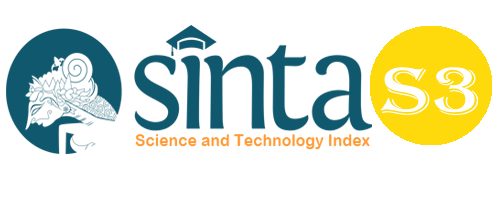Collembola Population Dynamics in Plants Organic Soybeans for Human Life
Abstract
The diversity of soil organisms creates a variety of functions and processes in the soil. Each community of organisms performs different functions, among others, as nitrogen fixer, phosphate solubilizer, decomposer of organic matter, producer of phytohormones and antibiotics, and can be viewed as a soil ecosystem. Soil fauna plays a very big role in improving soil fertility. Soil fauna is classified as mesofauna, one of which is Collembola. Collembola is a group of microarthropods that has a wide distribution in various types of soil in the world. The role of Collembola in the soil is to destroy organic matter into smaller sizes and then mix them. Collembola is widely used as a biological indicator and ecosystem monitoring. The results showed that: The population of Collembola in organic soybeans had a value of 183 individuals/m2, Biomass of Collembola in organic soybeans had a value of 2.56 mg/m2, Collembola diversity in organic soybeans had a value of 0.89 (classified as low), Population, biomass and diversity of Collembola have a good impact on soil fertility, so it is a positive thing for people who cultivate, especially organic soybeans. Organic soybean cultivation is a good product for people, especially those who currently prioritize health.
Keywords
Full Text:
PDFReferences
Apriantono A. (2008). Pertanian Organik dan Revitalisasi Pertanian. http://goorganik.com/mod.php?mod=publisher&op=viewarticle&cid=6&a rtid=9. [7 Maret 2021]
Arief A. (2001). Hutan dan Kehutanan. Yogyakarta: Kanisius
Badan Pusat Statistik. (2015). Data Produksi Tanaman Jagung, Padi dan Kedelai. Sumatera Utara. Medan
Coleman DC, Crossley DA and Hendrix PF. (2004). Fundamentals of Soil Ecology. London: Academic Press
Eaton RJ, Barberchek M, Buford M, Smith W. (2004). Effect of organic matter removal, soil compaction, and vegetation control on Collembola population. Pedobiologia 48:121-128
Fachrul, M.F. (2012). Metode sampling bioekologi. Edisi 1 Cetakan III. Jakarta: Bumi Aksara
Fitrahtunnisa dan Ilhamdi, M.L. (2013). Perbandingan keanekaragaman dan predominansi fauna tanah dalam proses pengomposan sampah organik. J. Bumi Lestari, 13(2), 413-421
Gobat JM, Aragno M, Matthey W. (2004). The Living Soil: Fundamentals of Soil Science and Soil Biology. USA: Science Publishers, Inc
Greenslade P, Deharveng L, Bedos A, Suhardjono YR. (2000). Handbook to Collembola of Indonesia. Cibinong: Fauna Malesiana (Draft final).
Kaneda S, Kaneko N. (2004). Growth of the Collembolan Folsomia candida Willem insoil supplemented with glucose. Pedobiologia 48:165-170
Imler U. (2004). Long-term fluctuation of soil fauna (Collembola and Orabatida) at ground water-near site in an alder wood. Pedobiologia 48:349-363
Indriyati dan Wibowo, L. (2008). Keragaman dan kemelimpahan Collembola serta Arthropoda tanah di lahan sawah organik dan konvensional pada masa bera. J. HPT Tropika, 8(2), 110-116
Kamal, M., Yustian, I. dan Rahayu, S. (2011). Keanekaragaman jenis Arthropoda di Gua Putri dan Gua Selabe kawasan karst Padang Bindu, OKU Sumatera Selatan. Jurnal Penelitian Sains, 14(1), 33- 37
Ludwig AJ, Reynolds FJ. (1988). Statistical Ecology: A Primer on Methods and Computing. New York: J Wiley
McLeod, LinesKelly, Tinning, Slavichand Moore. (2006). Soil organisms: benefits and management practices. Australia: NSW Department of Primary Industries
Migliorini M, Pigino G, Caruso T, Fanciulli PP, Leonzio C, Bernini F. (2005). Soil communities (Acari Oribatida; Hexapoda Collembola) in a clay pigeon shooting range. Pedobiologia 49: 1-13
Nurhayati. (2016). Pengaruh Jenis Amelioran Terhadap Efektivitas dan Infektivitas Mkiroba pada Tanah Gambut dengan Kedelai sebagai Tanaman Indikator. Jurnal Floratek, 6,124-139
Poerwowidodo. (1992). Metode Selidik Tanah. Surabaya:Penerbit Usaha Nasional
Priyono, B. dan Abdullah, M. (2013). Keanekaragaman jenis kupu-kupu di Taman Kehati UNNES. Biosaintifika, 5(2), 76-81
Rahmadi C, Suhardjono YR, Andayani I. 2004. Collembola lantai hutan di kawasan hulu Sungai Tabalong Kalimantan Selatan. Biota IX:179-185
Rahmadi, C. & Suhardjono, Y.R. (2007). Arthropoda gua di Nusakambangan Cilacap, Jawa Tengah. Zoo Indonesia, (16):21-29
Sabatini MA, Ventura M, Innocenti G. (2004). Do Collembola affect the competitive relationships among soil-borne plant pathogenic fungi? Pedobiologia 48:603-608
Sinka M, Jones TH, Hartley SE. (2007). the indirect effect of above-ground herbivoryin Collembola populations is not mediated by changes in soil water content. Appl Soil Ecol 36:92-99
Sugiyarto, Wijaya D, Suci YR. (2002). Biodiversitas hewan permukaan tanah pada berbagai tegakan hutan di sekitar gua Jepang, BKPH Nglerak, Lawu Utara, Kab. Karang Anyar. Biodiversitas 3(1):196-200
Sutanto. (2002). Penerapan Pertanian Organik, Pemasyarakatan & Pengembangannya. Yogyakarta: Kanisius
Suwondo. (2002). Komposisi dan Keanekaragaman Mikroarthropoda Tanah sebagai Bioindikator Karakteristik Biologi pada Tanah Gambut. http://www.unri.ac.id/jurnal/jurnal_natur/vol4%282%29/suwondo.pdf.Diakses pada Februari 2022
Tim Sintesis Kebijakan. (2008). Pemanfaatan Biota Tanah untuk Keberlanjutan Produktivitas Pertanian Lahan Kering Masam. Pengembangan Inovasi Pertanian 1 (2), 2008: 157-163. Balai Besar Penelitian dan Pengembangan Sumberdaya Lahan Pertanian, Bogor
Triplehorn CA, Johnson NF. (2005). Borror and Delong’s Introduction to the Study ofInsects 7 ed. USA: Brooks Cole
Trisnawati, I.D.T. dan Subahar, T.S. (2011). Kelompok trofik pada komunitas arthropoda tajuk dan lantai hutan di Hutan Gunung Tangkubanparahu-Jawa Barat: Ilustrasi dengan Diagram Trofik Hipotetik. Berkala Penelitian Hayati, 17: 119–125
Wahyudin, A., F.Y. Wicaksono, A.W. Irwan, Ruminta, dan R. Fitriani. (2017). Respon tanaman kedelai (Glycine max) varietas Wilis akibat pemberian berbagai dosis pupuk N, P, K, dan pupuk guano pada tanah inceptisol Jatinangor. Jurnal Kultivasi 16(2): 333-339
Zalilani, M. et al. (2019). Growth Response and Crop Production (Brassica Juncea L.) Against Watering Time Interval at Various Hydroponics Media. Budapest International Research in Exact Sciences (BirEx) Journal.P. 9-22.
DOI: https://doi.org/10.33258/birci.v5i1.4379
Article Metrics
Abstract view : 64 timesPDF - 26 times
Refbacks
- There are currently no refbacks.

This work is licensed under a Creative Commons Attribution-ShareAlike 4.0 International License.

This work is licensed under a Creative Commons Attribution-ShareAlike 4.0 International License.

_.gif)

















_.gif)



